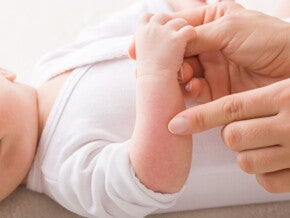
Whether you’re a first-time parent or simply looking for answers, this article will guide you through everything you need to know about infant nappy rash: from what causes it and what it looks like, to how you can treat and prevent it. Our goal is to help you feel supported and confident as you care for your baby’s delicate skin.
What is nappy rash?
Nappy rash, also known as diaper rash, is an inflammation of the skin in the area covered by a nappy. It typically presents as red, sore, or irritated skin on your baby’s bottom, thighs, or genital area.
This kind of rash is extremely common, especially in babies between 6 and 12 months of age. It often occurs when the skin has been in contact with moisture (from urine or stool), friction from the nappy, or new products such as wipes or detergents. The good news is that most cases are mild and can be treated with simple steps.
Types of nappy rash
Understanding the different types of nappy rash symptoms can help guide both recognition and the best treatment for your baby. While all forms involve skin irritation, the cause and appearance can vary.
Here are the most common types of infant nappy rash:
- Mild nappy rash: This is the most common form, presenting with mild redness or irritation, often where the nappy comes into contact with the skin. It usually resolves with frequent nappy changes and use of a barrier cream.
- Irritant contact dermatitis: This is caused by prolonged exposure to urine or stool. It often appears as widespread redness on the buttocks and inner thighs and the skin may feel raw or tender to touch.
- Psoriatic nappy rash: A less common type, this rash may appear as bright red, sharply defined patches. If there’s a family history of psoriasis, this may make this form of infant nappy rash more likely.
- Intertrigo: This rash is found in the folds of skin, such as between the thighs or around the groin. It appears red and moist and can become aggravated by heat, sweat or friction.
- Eczema (atopic dermatitis): Some babies with a personal or family history of eczema may also develop irritation in the nappy area. The skin may be dry, itchy and scaly, and the rash may extend beyond the typical nappy zone.
While the appearance may vary, most types of nappy rash symptoms respond well to gentle skin care and barrier protection. If symptoms persist or worsen, a healthcare professional can help determine if specific treatment is needed.
Nappy rash symptoms
The symptoms of nappy rash are usually easy to spot. Redness and inflammation in the nappy area are the most obvious signs, but there may be other skin changes to look out for:
- Red or pink patches on the skin;
- Swelling or puffiness in the nappy area;
- Skin that feels warm or tender to the touch;
- Shiny or slightly raised areas of irritation;
- Flaky, dry patches if the rash has been there for a few days;
- Small spots or bumps in cases of secondary infection.
It is important to note that nappy rash symptoms can look different depending on your baby’s skin tone. On lighter skin, it may appear pink or red. On darker skin, it might look brown, grey, purple, or ashen. Recognising these differences helps avoid missing the early signs of irritation.
Behavioural signs of nappy rash
In addition to visible changes, your baby may show signs of discomfort, such as:
- Crying or fussing during nappy changes;
- Disrupted sleep due to irritation;
- Pulling constantly at the nappy area;
- Being unsettled or feeding less than usual.
What causes nappy rash?
Nappy rash develops when the delicate skin under a nappy becomes irritated, but there are many different triggers that can contribute to flare-ups.
Common causes include:
- Prolonged contact with wet or soiled nappies: Urine and stool are both irritating to skin, especially when left for extended periods. A substance known as ammonia in urine and various enzymes in stool can break down the skin’s protective barrier when in constant contact.
- Friction and chafing: A very tight fitting nappy or excessive friction or rubbing during cleaning can damage sensitive skin. Tight-fitting plastic covers or nappies that don’t allow airflow can also trap heat and moisture, increasing irritation risk.
- New products: Some babies react to ingredients in wipes, soaps, lotions, or washing detergents.
- Recent illness or antibiotic use: Antibiotics can disrupt the skin’s natural balance, leading to fungal overgrowth or diarrhoea, both of which may contribute to nappy rash.
- Introduction of new foods: Starting solids may alter bowel habits, which can affect skin pH and lead to irritation.
- Thrush (Candida infection): Yeast infections may develop when the skin barrier is broken or after antibiotics.
- Underlying skin conditions: Eczema, for example, can make skin more reactive, and babies with ongoing diarrhoea may be at higher risk.
Even with the best hygiene, occasional nappy rash is normal in many infants, especially during times of change or illness. The key is recognising what causes nappy rash, the early signs, and responding quickly with appropriate care.
How is nappy rash diagnosed?
Most cases of nappy rash can be recognised at home, simply by observing your baby’s skin. The rash typically appears in the area covered by the nappy and may range from mild redness to more intense inflammation .
What to look for:
- Red, irritated skin on the buttocks, thighs or genitals;
- Shiny or raw patches;
- Discomfort during nappy changes;
- Small spots or signs of infection in more advanced cases.
If you’re unsure or if symptoms are not improving, it is important to speak with your GP or child health nurse. Health professionals will help to assess:
- Appearance and pattern of the rash;
- Your baby’s medical history and recent changes (e.g. illness, new foods, antibiotics);
- Possible underlying conditions, such as eczema or fungal infection;
- Possible triggers.
In some cases, your doctor may recommend specific creams or treatments tailored to your baby’s needs.
Nappy rash treatment
Most mild cases of nappy rash can be managed at home with simple measures. Here are some effective nappy rash treatments:
- Change nappies frequently as soon as they are wet or soiled.
- Gently cleanse the area with warm water and a soft cloth (avoid wipes with alcohol or added fragrances).
- Allow nappy-free time to help skin breathe, recover and for air to circulate freely.
- Apply a thick layer of barrier cream or ointment (e.g. zinc oxide or petroleum jelly) after every nappy change – so that you cannot see the skin through the cream.
- Use breathable nappies and avoid tight-fitting plastic covers.
- Avoid using powders or antiseptics unless advised by a doctor.
- Give your child fluids in the evening to minimise nappy wetting overnight.
- Consider reducing highly acidic foods such as citrus or tomato-based foods during nappy rash, as this may exacerbate nappy rash.
- Watch for signs of infection and seek advice if needed.
With the right care, most rashes improve in 2 to 3 days. If not, seeking further advice may be helpful.
How to prevent nappy rash
Prevention is often simpler than treatment and developing a consistent nappy care routine can go a long way to help. Here are practical steps to reduce the risk of developing nappy rash:
- Change nappies often, especially after stools;
- Clean the area gently with warm water or fragrance-free wipes;
- Give nappy-free time daily to let skin breathe;
- Use a protective barrier cream every change (even when skin looks healthy);
- Rinse cloth nappies thoroughly to remove detergent residues;
- Avoid fragranced products or harsh soaps;
- Keep your baby well hydrated to support overall skin health;
- Monitor for signs of sensitivity when introducing new foods or products;
- Avoid plastic pants or nappies that trap moisture.
Remember, even with consistent prevention, occasional flare-ups may still occur particularly during teething, illness, or when bowel habits change. The goal is to reduce how often and how severe the nappy rash becomes.
When to see a doctor for nappy rash
While most nappy rashes are mild and resolve quickly, some cases may require medical attention. Be alert to the following signs:
- Rash that seems to be getting worse or spreading;
- Rash that has not improved after a week;
- Rash accompanied by fever that is otherwise unexplained;
- Signs of pain, bleeding, or intense itching;
- Rash with blisters, open sores, or yellow discharge and crusts (possible infection);
- Noticeable changes in feeding, sleeping, or general behaviour.
If you are ever unsure, speak with your maternal child health nurse or GP. It is better to seek help early rather than to wait.
Supporting your baby’s skin, every step of the way
Nappy rash is a normal part of infancy and something nearly all families encounter. It is a sign that your baby’s skin needs a little extra care and attention during this phase of rapid growth and change.
The good news is that most cases are mild, short-lived, and manageable at home. With regular nappy changes, gentle cleansing, and barrier protection, you can usually prevent or treat flare-ups quickly.
Remember, every baby’s skin is unique. If you’re ever concerned or the rash doesn’t seem to be healing, don’t hesitate to speak with your healthcare professional. With the right guidance and care, your baby’s skin will be back to soft and healthy in no time.
Frequently asked questions about nappy rash
How do you treat nappy rash?
Treating nappy rash starts with keeping the skin as clean and dry as possible. Change your baby’s nappy frequently ideally as soon as it becomes wet or soiled. Clean the area gently with warm water or fragrance-free wipes, then pat dry. Apply a thick layer of barrier cream containing zinc oxide or petroleum jelly at each nappy change. Give your baby nappy-free time every day to let the skin breathe. Most mild cases clear up within a few days with consistent care.
How to treat bad nappy rash?
If your baby has a more severe rash with raw, red skin or signs of discomfort, continue using barrier cream but also check for possible causes such as yeast infections or reaction to new products. Use gentle cleansing, ensure frequent changes, and speak to your GP if the rash isn’t improving after 7 days despite care, or appears infected (e.g. blisters, pus, fever).
What are the main causes of nappy rash?
The most common cause is prolonged contact with wet or soiled nappies, which irritates the skin. Other triggers include friction, reactions to wipes or detergents, yeast infections (thrush), recent use of antibiotics, and dietary changes such as starting solid foods. Babies with eczema or diarrhoea may be more prone to flare-ups.
What can be mistaken for nappy rash?
Some conditions may resemble nappy rash but require different treatment. These include eczema, seborrhoeic dermatitis, psoriasis, and yeast (Candida) infections, which can cause more widespread or persistent symptoms. If the rash is not improving, or appears unusual in colour or shape, it’s best to have it reviewed by your GP.
Do baths help with diaper rash?
Yes, warm baths can soothe irritated skin, especially if your baby has sensitive or inflamed areas. Use plain water or add a few tablespoons of colloidal oatmeal to calm the skin. Avoid soaps, bubble baths, or fragranced products, which can worsen irritation. Gently pat your baby dry and apply a barrier cream after each bath.
Sources:
- The Sydney Children’s Hospitals Network Website. Accessed at https://www.schn.health.nsw.gov.au/nappy-rash-factsheet
- Raising Children Website. Accessed at https://raisingchildren.net.au/newborns/health-daily-care/poos-wees-nappies/nappy-rash
- Better Health Channel Website. Accessed at https://www.betterhealth.vic.gov.au/health/healthyliving/nappy-rash
- Royal Children’s Hospital Website. Accessed at https://www.rch.org.au/kidsinfo/fact_sheets/nappy_rash/
- The Australasian College of Dermatologists Website. Accessed at https://www.dermcoll.edu.au/atoz/nappy-rash/
- Health Direct Website. Accessed at https://www.healthdirect.gov.au/nappy-rash



